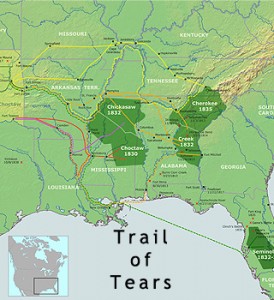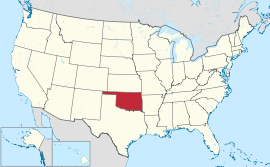Oklahoma
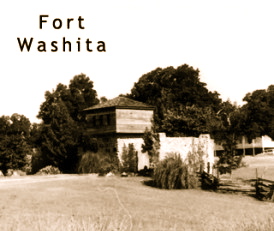
Trail of Tears Documentary Made by Forest and Austin
Andrew Jackson’s Indian Removal Act passed in 1830 was in effect for the 15,000 Native Cherokee’s with an estimated 4,000,000+ dead after the two years in which they had to relocate east of the Mississippi from the Northern Georgia area in 1838 and 1839 in an exchange of land which was never accepted by ANY Native American tribe or leader. In a sad and shameful episode of American history, in the 1830s, thousands of Cherokee men, women, and children were removed from their homes in the Southeastern United States and forced to march over a thousand miles to what is now Oklahoma. Over 4,000 died as a result of the removal. The route they took and the journey itself has become known as “The Trail of Tears,” or, the literal translation from the Cherokee, “The Trail Where They Cried.”
- (1682) French explorer Robert Cavelier, Sieur de la Salle claimed Oklahoma for France
1800’s
- (1803) U.S. acquired most of Oklahoma from France in the Louisiana Purchase
- (1830’s – 1840’s) The Cherokee, Chickasaw, Choctaw, Creek and Seminole (called the Five Civilized Tribes) were forced to relocate from their native lands (by the U.S. government) into Oklahoma, known then as the Indian Territory. Thousands of native Americans lost their lives on the bloody marches to Oklahoma.
- (1842) Remaining Seminole Indians (from Florida) moved to Oklahoma
- (1860’s) After the Civil War, because the Indians had sided with the Confederacy, they faced ruin and forfeiture of their lands
- (1870’s) An additional 25 tribes were moved to Oklahoma to reside on federal lands
- (1872) The railroad crossed Oklahoma, and routes of commerce began to open
 (1875) At the Battle of Washita, George Custer defeated remaining Indian forces, and in general terms the Indian wars ended
(1875) At the Battle of Washita, George Custer defeated remaining Indian forces, and in general terms the Indian wars ended- (1889) U.S. government opened all unassigned Oklahoma lands for settlement, and thousands of settlers crossed the border to stake their claims
- (1890) Oklahoma Territory created, coexisted with the Indian Territory
Oklahoma (![]() i/ˌoʊkləˈhoʊmə/) (Pawnee: Uukuhuúwa, Cayuga: Gahnawiyoˀgeh) is a state located in the South Central region of the United States of America. Oklahoma is the 20th most extensive and the 28th most populous of the 50 United States. The state’s name is derived from the Choctaw words okla and humma, meaning “red people,” and it is known informally by its nickname, The Sooner State. Formed by the combination of Oklahoma Territory and Indian Territory on November 16, 1907, Oklahoma was the 46th state to enter the union. Its residents are known as Oklahomans or, informally “Okies”, and its capital and largest city is Oklahoma City.
i/ˌoʊkləˈhoʊmə/) (Pawnee: Uukuhuúwa, Cayuga: Gahnawiyoˀgeh) is a state located in the South Central region of the United States of America. Oklahoma is the 20th most extensive and the 28th most populous of the 50 United States. The state’s name is derived from the Choctaw words okla and humma, meaning “red people,” and it is known informally by its nickname, The Sooner State. Formed by the combination of Oklahoma Territory and Indian Territory on November 16, 1907, Oklahoma was the 46th state to enter the union. Its residents are known as Oklahomans or, informally “Okies”, and its capital and largest city is Oklahoma City.
A major producer of natural gas, oil, and agriculture, Oklahoma relies on an economic base of aviation, energy, telecommunications, and biotechnology. It has one of the fastest growing economies in the nation, ranking among the top states in per capita income growth and gross domestic product growth. Oklahoma City and Tulsa serve as Oklahoma’s primary economic anchors, with nearly 60 percent of Oklahomans living in their metropolitan statistical areas.
With small mountain ranges, prairie, and eastern forests, most of Oklahoma lies in the Great Plains and the U.S. Interior Highlands—a region especially prone to severe weather. In addition to having a prevalence of German, Irish, English, Scottish, and Native American ancestry, more than 25 Native American languages are spoken in Oklahoma, the most of any state. It is located on a confluence of three major American cultural regions and historically served as a route for cattle drives, a destination for southern settlers, and a government-sanctioned territory for Native Americans. As part of the Bible Belt, widespread belief in evangelical Christianity makes it one of the most politically conservative states, though Oklahoma has more voters registered with the Democratic Party than with any other party.
History
Evidence exists that native peoples traveled through Oklahoma as early as the last ice age, but the state’s first permanent inhabitants settled in communities accentuated with mound-like structures near the Arkansas border between 850 and 1450 AD. Spaniard Francisco Vásquez de Coronado traveled through the state in 1541, but French explorers claimed the area in the 1700’s and it remained under French rule until 1803, when all the French territory west of the Mississippi River was purchased by the United States in the Louisiana Purchase.
During the 19th century, thousands of Native Americans were expelled from their ancestral homelands from across North America and transported to the area including and surrounding present-day Oklahoma. The Choctaw was the first of the “Five Civilized Tribes” to be removed from the southeastern United States. The phrase “Trail of Tears” originated from a description of the removal of the ChoctawNation in 1831, although the term is usually used for the Cherokee removal. About 17,000 Cherokees – along with approximately 2,000 black slaves owned by Cherokees – were removed from their homes. The area, already occupied by Osage and Quapawtribes, was called for the Choctaw Nation until revised Native American and then later American policy redefined the boundaries to include other Native Americans. By 1890, more than 30 Native American nations and tribes had been concentrated on land within Indian Territory or “Indian Country.” Many Native Americans served in the Union and Confederate military during the American Civil War. The Cherokee Nation had an internal civil war. Slavery in Oklahoma was not abolished until 1866.
In the period between 1866 and 1899, cattle ranches in Texas strove to meet the demands for food in eastern cities and railroads in Kansas promised to deliver in a timely manner. Cattle trails and cattle ranches developed as cowboys either drove their product north or settled illegally in Indian Territory. In 1881, four of five major cattle trails on the western frontier traveled through Indian Territory. Increased presence of white settlers in Indian Territory prompted the United States Government to establish the Dawes Act in 1887, which divided the lands of individual tribes into allotments for individual families, encouraging farming and private land ownership among native Americans but expropriating land to the federal government. In the process, railroad companies took nearly half of Indian-held land within the territory for outside settlers and for purchase.
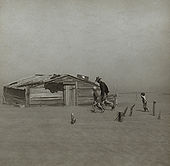 The Dust Bowl sent thousands of farmers into poverty during the 1930’s.
The Dust Bowl sent thousands of farmers into poverty during the 1930’s.
Major land runs, including the Land Run of 1889, were held for settlers where certain territories were opened to settlement starting at a precise time. Usually land was open to settlers on a first come first served basis. Those who broke the rules by crossing the border into the territory before the official opening time were said to have been crossing the border sooner, leading to the term sooners, which eventually became the state’s official nickname.
Deliberations to make the territory into a state began near the end of the 19th century, when the Curtis Act continued the allotment of Indian tribal land. Attempts to create an all-Indian state namedOklahoma and a later attempt to create an all-Indian state named Sequoyah failed but the Sequoyah Statehood Convention of 1905 eventually laid the groundwork for the Oklahoma Statehood Convention, which took place two years later. On November 16, 1907, Oklahoma was established as the 46th state in the Union.
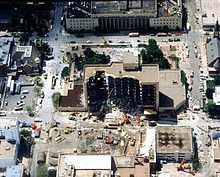 The bombing of the Alfred P. Murrah Federal Building in Oklahoma City was one of the deadliest acts of terrorism in American history.
The bombing of the Alfred P. Murrah Federal Building in Oklahoma City was one of the deadliest acts of terrorism in American history.
The new state became a focal point for the emerging oil industry, as discoveries of oil pools prompted towns to grow rapidly in population and wealth. Tulsa eventually became known as the “Oil Capital of the World” for most of the 20th century and oil investments fueled much of the state’s early economy. In 1927, an Oklahoman businessman Cyrus Avery, known as the “Father of Route 66”, began the campaign to create U.S. Route 66. Using a stretch of highway from Amarillo, Texas to Tulsa, Oklahoma to form the original portion of Highway 66, Avery spearheaded the creation of the U.S. Highway 66 Association to oversee the planning of Route 66, based in his hometown of Tulsa.
Oklahoma also has a rich African American history. There were many black towns that thrived in the early 20th century because of black settlers moving from neighboring states, especially Kansas. The politician Edward P. McCabe encouraged black settlers to come to what was then Indian Territory. He discussed with President Theodore Roosevelt the possibility of making Oklahoma a majority-black state.
By the early 20th century, the Greenwood neighborhood of Tulsa was one of the most prosperous African-American communities in the United States. Jim Crow laws had established racial segregation since before the turn of the century, but the blacks had created a thriving area.
Social tensions were exacerbated by the revival of the Ku Klux Klan after 1915. The Tulsa Race Riot broke out in 1921, with whites attacking blacks. In one of the costliest episodes of racial violence in American history, sixteen hours of rioting resulted in 35 city blocks destroyed, $1.8 million in property damage, and a death toll estimated to be as high as 300 people. By the late 1920s, the Ku Klux Klan had declined to negligible influence within the state.
During the 1930s, parts of the state began suffering the consequences of poor farming practices, extended drought and high winds. Known as the Dust Bowl, areas of Kansas, Texas, New Mexico and northwestern Oklahoma were hampered by long periods of little rainfall and abnormally high temperatures, sending thousands of farmers into poverty and forcing them to relocate to more fertile areas of the western United States. Over a twenty-year period ending in 1950, the state saw its only historical decline in population, dropping 6.9 percent as impoverished families migrated out of the state after the Dust Bowl.
Soil and water conservation projects markedly changed practices in the state and led to the construction of massive flood control systems and dams; they built hundreds of reservoirs and man-made lakes to supply water for domestic needs and agricultural irrigation. By the 1960s, Oklahoma had created more than 200 lakes, the most in the nation.
In 1995, Oklahoma City was the site of the worst act of domestic terrorism in American history. The Oklahoma City bombing of April 19, 1995, in which Timothy McVeigh and Terry Nichols detonated an explosive outside of the Alfred P. Murrah Federal Building, killed 168 people, including 19 children. The two men were convicted of the bombing: McVeigh was sentenced to death and executed by the federal government on June 11, 2001; his partner Nichols is serving a sentence of life in prison without the possibility of parole. McVeigh’s army buddy, Michael Fortier, got 12 years in prison and, ultimately, a $75,000 fine for helping sell guns (to raise funds for the bombing) and for helping to examine the Murrah Federal building prior to the terrorist attack. Wife, Lori Fortier (now dead), was granted immunity for testifying.

